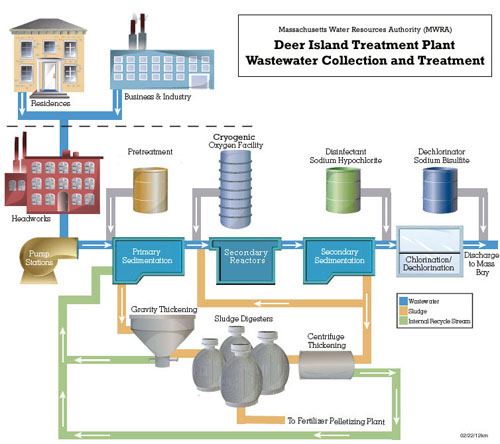| Home |
| About MWRA |
| Water System |
| Sewer System |
| Harbor and Bay |
| School Program |
| Doing Business with MWRA |
| Contact MWRA |
How
the Sewer System Works
Massachusetts Water Resources Authority
WHERE
DOES ALL THE SEWAGE COME FROM?
From
people using water in kitchens and bathrooms in their homes and from commercial
and industrial use. Nearly half the state's population, over 2 million people
in 43 communities, send sewage to MWRA's treatment plants on the shores
of Boston Harbor. Over 5,500 businesses and industries contribute wastewater
as well. In addition, nearly half of the total flow in MWRA sewers is from
rainy-weather street runoff and from below-ground cracks and faulty connections
that allow groundwater into the system.
HOW
DOES SEWAGE GET TO THE TREATMENT PLANTS?
Sewage
travels through three different sets of pipes. Water that is used in a home
or industry is flushed through a building's pipes until it reaches local
sewers which are owned and operated by city and town sewer departments.
These 5,100 miles of local sewers transport the wastewater into 227 miles
of MWRA interceptor sewers. The interceptor sewers, ranging from 8 inches
to 11 feet in diameter, carry the region's wastewater to two MWRA treatment
plants. Though most of the wastewater flows by gravity some low-lying areas
require pumping.
HOW DOES SEWAGE TREATMENT WORK?
MWRA
provides preliminary primary and secondary treatment to its wastewater flows
at the Deer Island Treatment Plant.
The first phase of secondary treatment began operating in July 1997. The
treatment process is as follows:
Collection and Pumping
Sewage is piped from communities to several headworks where bricks, logs and other large objects are screened out. Pumps draw the sewage through deep-rock tunnels under the harbor to Deer Island.Preliminary Treatment
Mud and sand settle in a tank called a grit chamber. Later, this material, known as grit and screenings, is taken to a landfill for environmentally safe disposal.Primary Treatment
The sewage then flows to primary settling tanks where up to 60% of the solids in the waste stream settle out as a mixture of sludge and water. This primary treatment removes very few toxic chemicals.Secondary Treatment
In the secondary treatment plant oxygen is added to the wastewater to speed up the growth of micro-organisms. These microbes then consume the wastes and settle to the bottom of the secondary settling tanks. After secondary treatment, 80-90% of human waste and other solids have been removed. A significant proportion of toxic chemicals are also removed by this process.
WHERE
DOES ALL THE TREATED WASTEWATER AND SLUDGE GO?
The
remaining wastewater is disinfected before it is discharged to the receiving
waters (Massachusetts Bay). This stream of treated wastewater, known as
effluent, travels through a 9.5-mile Outfall
Tunnel bored through solid rock more than 250 feet below the ocean
floor. The tunnel's last mile and a quarter include 55 separate release
points known as "diffusers." By extending to an area with water depths
up to 120 feet, this outfall provides a much higher rate of mixing and/or
dilution than is possible with present discharges into the shallow waters
of Boston Harbor.
Sludge from primary and secondary treatment is processed further in
sludge digesters, where it is mixed and heated to reduce its volume and
kill disease-causing bacteria. It is then transported through the Inter-Island Tunnel to the pelletizing plant in Quincy, where it is dewatered, heat-dried and converted to a pellet fertilizer for use in agriculture, forestry and
land reclamation.
AREN'T TOXIC CHEMICALS
A PROBLEM?
Yes.
If excessive levels of toxic chemicals are allowed to enter the system,
they could either prevent the safe application of sludge as fertilizer
or threaten the marine environment if discharged to ocean waters.
New regulations have been written by the MWRA to control the amount of
toxic chemicals that companies can discharge into the sewer system. The
MWRA's Toxic Reduction and Control Department
is responsible for monitoring and enforcing the regulations and imposes
fines against industrial polluters. The MWRA also works with industries
to encourage reductions in the use of toxic chemicals that might be discharged
into the sewer system.
Households are also an important source of toxic chemicals due to the
careless dumping of toxic products down household drains. Used motor oil,
pesticides, paints, solvents and even many household cleaners pose significant
hazards to the environment. For most household jobs, less toxic alternatives
are available.
Updated February 22, 2012
